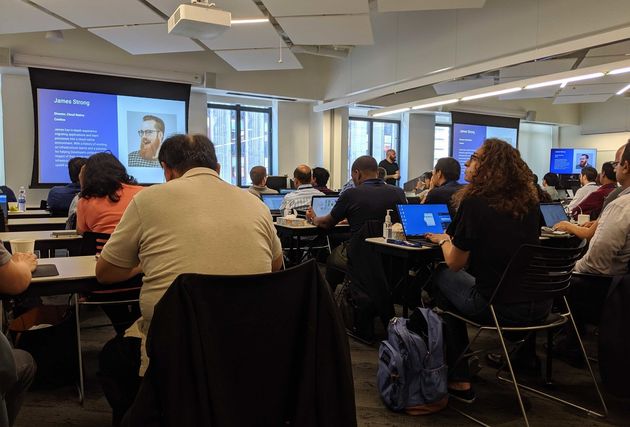What Is IT ROI in the Digital Era? (And What It Isn’t)
Maximising the return-on-investment (ROI) of IT spend has traditionally centred around the ‘iron triangle’: cost, quality, time.
Can you deliver high-quality software, on time and on budget?
If the CTO was under pressure to deliver more for less, those were the three dials that would need to be tweaked.
But in the modern IT era—characterised by rapid technology shifts and rising customer expectations—digital excellence is so ubiquitous that if you fail on any of the three corners of the triangle, you’re already dead in the water!
Satisfying the iron triangle is now the starting point of any successful digital venture. Customers have come to expect nothing less!
In this new world, the new source of competitive advantage is the customer experience. As IT becomes increasingly commoditised, it’s the focus on the customer that makes all the difference.
How does this affect how we look at IT ROI? To the inward-looking iron triangle, we need to add an outward-looking fourth dimension: customer-centric innovation.
In this article, I’ll look quickly at how the rules of the game have changed, and what you need to focus on to maximise IT ROI in the digital era.
IT ROI Is Changing: Key Drivers
There are two key drivers behind this ROI paradigm shift: the commodification of technology and skyrocketing customer expectations.
The technology underpinning digital excellence is increasingly taken for granted. Using cloud-native technologies like serverless, for example, means you can abstract away almost the entire tech stack.
Increasingly, your tech stack itself no longer separates you from your competition. Instead, the pure business logic—i.e. the application code you write and the value it delivers—is the only point of differentiation.
As businesses hone in even more tightly on the business logic, customer expectations have gone through the roof, with seamless, intuitive and ever-evolving digital experiences increasingly the norm.
IT ROI is no longer a direct function of technical outcomes, but business and customer outcomes.
This means that the focus of your IT department must shift from technical outcomes to business and customer outcomes.
This has a massive impact on how ‘successful’ IT is measured, to which we will now turn!
ROI in the Digital Era: Measuring Customer-Centric Innovation
If the customer experience is the new source of competitive advantage, then IT ROI comes from consistently delivering innovative digital customer experiences.
Where IT has previously been thought of as a cost-centre, it must now step forward and take centre stage as the central engine of business value!
From a technical perspective it’s all about delivering rapid innovation. Here are some key metrics to keep an eye on.
- Lead time: the time it takes to go from ideation to production
- Release frequency: can you deploy small changes every day?
- Mean-time-to-recovery: if there is a delay, how long does it take to rectify?
- Change fail percentage: how reliably successful are your deployments?
Crucially, these must be married tightly with rapid customer feedback loops. Your IT speed is merely aesthetic unless you know what you will be creating is valuable.
You must be able to track how users are interacting with your digital products. Where are they dropping off? Where do they get stuck? Why do they abandon the site at certain pages? This information must then be fed back into your existing backlog of updates and features requests.
The combination of rapid innovation and tight feedback loops is what leads to customer-centric innovation: turning your ideas into delighted customers and then into revenue as quickly as possible.
If you can rapidly turnaround digital features that delight your customers, ROI is assured.
Monzo is a case study of how to do it right. They have a clear roadmap of user features that they plan to roll out on the basis of careful listening to their community of users. They exist together in a symbiotic relationship: the users know they will be listened to, so they provide masses of feedback and ideas; the company genuinely listens and changes tack based on user feedback, so they get the information they need to build the right products. Alongside, they have a legendary cloud-native engineering function that can deliver the roadmap at pace.
How to Deliver Customer-Centric Innovation at Speed and Scale
A central challenge is that while you enhance your ability to deliver customer-centric innovation, you must still maintain the three corners of the traditional iron triangle.
In fact, cost, time and quality are more relevant than ever! Nowadays, customer complaints can spread like wildfire on social media and the line between success and failure gets thinner and thinner.
So how do you balance the added complexity of innovation while keeping the lights on?
Modern software delivery approaches bake the tenets of the iron triangle into the same processes that allow you to go fast.
For example, using the public cloud will have your applications operating in a highly redundant, highly available, auto-scaling manner, all of which can actually cost less and result in better software than traditional approaches.
Dealing with security, compliance and regulation is another excellent example. Using a DevSecOps operating model means that security is ‘shifted left’ in the software delivery lifecycle, while ensuring tight feedback loops across the value chain. Similarly, compliance and regulatory requirements can be ‘baked’ into software pipelines early on.
In both cases, you no longer need an army of security and regulation specialists but instead work with a smaller, smarter team that works with engineers to ensure security and compliance from the outset. The result is fewer fines for non-compliance and lower cost overheads. And the money saved can be reassigned to innovation and differentiating projects.
Conclusion
To sum up, in the digital era IT ROI has shifted from a focus on the tech stack to the actual customer experience. The IT department is no longer a cost centre that keeps the lights on, but is the source of competitive advantage, responsible for delivering the innovative digital excellence that will impress and retain customers.
How you measure your ROI must reflect this fact!




